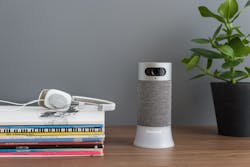Honeywell on Wednesday rolled out its new self-installed and self-monitored Smart Home Security System, which is designed to fit the needs of today’s do-it-yourself (DIY) consumers. However, unlike most product launches, Honeywell decided to introduce the new system through Indiegogo, a popular crowdfunding website for tech start-ups.
Although the partnership with Indiegogo may seem like an unusual fit on the surface considering the vast R&D resources of Honeywell, Scott Harkins, vice president of IoT Partner Programs for Honeywell Connected Home, says that they really wanted to tap into the valuable feedback that’s provided by the tech-minded people who invest in products on the site.
“This product has been developed. We built this within Honeywell and we look at Indiegogo as a platform that attracts tech-forward thinking people and early adopters of new technology, particularly in the smart home,” Harkins explains. “What we’re really hoping to do is create a community of these early adopters who will receive the product prior to the general market, play around with it and come back to us – via a direct relationship – and provide feedback and ideas about what it does, what it can do better and, more importantly, what it doesn’t do.”
Some of the specific things Harkins says Honeywell is looking to find out from these early adopters is how they like system’s integration with Amazon’s Alexa Voice Service and whether or not they would prefer to have a professional monitoring option, which would obviously benefit the company’s professional dealers.
“We fully expect that as consumers begin to use the product, particularly these early adopters, that they will think, ‘alright, I have a security system and it’s great, I see value in knowing what is going on in my home but I also see value in someone reacting to it – dispatching police, fire, etc.’ We want the consumers to tell us before we tell them,” he says. “It would be interesting to see if Siri (integration) is something they desire or if they want more video or other types of sensors. “
While the company is making the system available to early adopters now via Indiegogo, it will not make its official debut until CES 2018 in January. In a statement issued last month, Honeywell said the system would also be made its available to its dealers beginning early next year.
In looking at the market penetration rates of professionally installed and monitored security systems, which have historically hovered between 20 to 25 percent of U.S. households, and comparing them with surveys of people who would like a security system but don’t want to pay for installation or a long-term contract, Harkins says they believe there is an opportunity in that middle market – comprising an estimated 66 million households – for dealers to offer a different kind of product. “Many of our (dealer) customers are already in the DIY space and this is a different kind of offering that allows them to serve that market at a lower cost and, at some point in the future, even offer monitoring services on it,” he adds.
However, Harkins acknowledges that their professional dealer base isn’t really interested in just providing hardware and that there would have to be recurring revenue tied to it via monitoring for them to offer it to customers. “I would say because of what is listed on Indiegogo today – we hinted at some upcoming features that aren’t on the product from day one – but I would say If you looked a little bit longer term, maybe one horizon out, it wouldn’t be that shocking that the Smart Home Security System has the ability to be professionally monitored,” he says.
Despite having a professional dealer channel, Harkins says that Honeywell has always gone to market with a “omni-channel” approach, especially within their “comfort” portfolio which includes products like thermostats, humidifiers and things along those lines. According to Harkins, by offering products through retail outlets they are able to increase Honeywell brand awareness among consumers.
“And brand awareness creates opportunity for our professional channels and when they present a product to the consumer, that consumer already knows the brand and is comfortable with it,” Harkins says. “Honeywell has been around for over 100 years and we’ve been in the security space for 85 years and, ultimately, I think it’s about creating the brand and the brand then feeds back to the professional.”
And though the recently shuttered DragonFly solution, which was a self-installed but professionally monitored security system, did not gain the traction that Honeywell had hoped, Harkins says that it is very different from the Smart Home Security System and that they’ve taken lessons learned from it and will apply them moving forward.
“The experience of DragonFly and what we built and how we took it to market has really influenced this product. These are two very, very different products, however; some of the technology we used in DragonFly has been reused here. Some of our learnings about consumers and how they want to interact with a professionally monitored security system have been implemented here but these are very, very different products,” Harkins explains. “Where DragonFly was effectively a camera, the Smart Home Security System is a camera, security system, Amazon Echo, and even features other voice services. It is a significantly different product that really becomes the center of the connected home.”
For more information about the new system, click here.
About the Author:
Joel Griffin is the Editor-in-Chief of SecurityInfoWatch.com and a veteran security journalist. You can reach him at [email protected].



